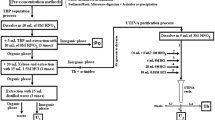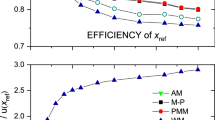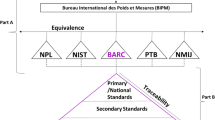Abstract
The Korea Research Institute of Standards and Science (KRISS) has been conducting proficiency tests of the radioactivity measurement of gamma-ray emitting radionuclides for domestic institutes in Korea. The test scheme used the z′-score with a robust analysis based on the International Standard Organization (ISO) 17043 and ISO 13528 standards for evaluating the measurement performance. The z′-score employed a robust standard deviation by Algorithm-A in the ISO 13528 standard instead of using a traditional standard deviation of participant results. The proficiency test materials (PTMs) were prepared by spiking a diluted standard solution of radionuclides of interest into acidified water with 1 M HCl. Combinations of 134Cs, 137Cs, 57Co, 60Co, 88Y, 113Sn, and 51Cr were used as PTMs. KRISS satisfies proficiency testing requirements, and the test is accredited by the Korea Laboratory Accreditation Scheme (KOLAS). KRISS has conducted proficiency tests annually since 2016, and more than 70 laboratories have tested over 650 test items so far. This study presents the results provided by the participants and the observed trends.
Similar content being viewed by others
Avoid common mistakes on your manuscript.
1 Introduction
The proficiency test of radioactivity measurement is used to exercise the competence of accredited radioactivity testing laboratories because International Standard Organization (ISO) 17025 standard requires proficiency testing to the accredited bodies for checking the entire quality assurance system [1]. Proficiency tests conducted to analyze the radioactivity of naturally occurring radionuclides or synthetic radioisotopes in various matrices including food, water, and soil at environmental levels also help perform comparisons among laboratories [2, 3].
Since 1997, the Korea Institute of Nuclear Safety and Technology (KINS) has conducted a domestic interlaboratory comparison program in Korea [4]. This program is mainly aimed at improving the reliability of radioactivity analysis data produced by domestic radioactivity analysis laboratories, analysis technology, and analysis ability of radioactivity analysis practitioners. However, as the nuclear accident at the Fukushima Daiichi Nuclear Power Plant led to an increase in the number of participants in this program, since 2013, this program has been limited to only local radioactivity monitoring stations under KINS as well as nuclear power plants and related businesses.
In this light, other laboratories that did not participate in this program, such as bodies accredited for radioactivity analysis by the Korea Laboratory Accreditation Scheme (KOLAS), raised the need for a separate proficiency test. The Korea Research Institute of Standards and Science (KRISS) decided to provide an accredited radioactivity proficiency test with metrological traceability to radioactivity standards. KRISS could produce proficiency test materials (PTMs) since it had already been providing certified reference materials (CRMs) for radioactivity analysis since the 1980s. Moreover, KRISS could satisfy all other technical requirements for proficiency testing [5]. Therefore, KRISS performed a pilot test to establish a proficiency test scheme in 2015.
2 Test method and discussion
2.1 Proficiency test scheme
The KRISS proficiency test aims to improve the measurement reliability of participating laboratories by testing the radioactivity measurement of gamma-ray emitting nuclides in various matrices such as water, foods, and soil using high-purity germanium (HPGe) detectors.
Although the pilot test by KRISS has requirements for the analysis method and equipment, no major issues have been reported regarding this test. Participants analyzed PTMs using one of the methods, ISO 18589–3 or Food Code by Ministry of Food or Drug Safety of the Republic of Korea, with HPGe detectors [6, 7]. Nevertheless, the uncertain evaluation of participants exhibited wide variations, with less-experienced participants being outliers. KRISS noted that robust statistical methods needed to be applied to minimize the influence of outliers from the pilot test as they could make conventional statistical techniques unreliable.
KRISS used the z′-score with a robust analysis algorithm as a performance score for the proficiency assessment, because the uncertainties reported by participants were considered unreliable. The standard uncertainty of the assigned value for a test item in the PTMs was approximately 2%; this uncertainty could not be ignored relative to the roughly 5% standard deviation of the reported values. Therefore, one risk is that some participants may receive action signals because of inaccuracies in the assigned value rather than because of something they have done. In this light, the uncertainty of the assigned value needs to be considered together with a robust standard deviation of participant results. The robust standard deviation was determined using Algorithm-A, a robust analysis algorithm, by eliminating outliers. Algorithm-A provides alternative estimators of the mean and standard deviation for roughly normally distributed data; it is the most useful method where the expected proportion of outliers is below 20% [8]. KRISS employed the alternative standard deviation instead of the standard deviation of the reported values. The performance score of the KRISS proficiency test can be expressed as follows:
where xlab is the value reported by a participant; xKRISS and uKRISS are the assigned value and its standard uncertainty, respectively; and σRobust is the robust standard deviation of the participants obtained using algorithm-A. The robust standard deviation was derived by an iterative calculation that is explained in Annex C.3 of the ISO 13428:2015 standard [8]. |z′|≤ 2.0 was considered acceptable and generated no signal, 2.0 <|z′|< 3.0 was considered to give a warning signal, and |z′|≥ 3.0 was considered unacceptable and generated an action signal.
2.2 PTMs
PTMs were prepared from a combination of isotopes among 134Cs, 137Cs, 57Co, 60Co, 88Y, 113Sn, and 51Cr. Cesium is a nuclide that can be released during a major nuclear power plant accident. Therefore, 134Cs and 137Cs are treated as screening radionuclides with 131I in the Republic of Korea. Both nuclides have appeared in all proficiency tests to allow continuity to be established. 60Co and 88Y as well as 134Cs may be used to adjust the difficulty of the proficiency test because the true coincidence summing should be considered due to their prompt cascade gamma-ray release. The remaining radionuclides, namely, 113Sn, 51Cr, and 57Co, are considered for radioactivity analysis in the low-energy region. In particular, 51Cr has a relatively short half-life, and therefore, decay correction may be needed during the measurement. Table 1 shows the list of nuclides in the PTM for each year and their assigned values for the proficiency test. The difficulty of the proficiency test was adjusted by selecting the nuclides and their radioactivity concentration in the PTM.
The radioactivity concentration of each gamma-ray emitting nuclide in the PTMs is measured using the reference ionization chamber, which is a secondary standard in KRISS. The ionization chamber is calibrated using the two primary systems, namely, the 4πβ(LS)-γ(NaI(Tl)) coincidence counting system and triple-to-double coincidence ratio (TDCR) system in KRISS [9, 10]. Therefore, all assigned values of the nuclides in the PTMs are metrologically traceable to the KRISS primary standards.
The first step in PTM preparation was to make a mixed solution by sampling individual radionuclide solutions whose radioactivity concentrations have been determined in the KRISS reference ionization chamber. First, 10 g of mixed solution acidified with 1 M HCl was prepared in a 20 ml glass vial. Then the solution was diluted with water that was acidified with 1 M HCl to between 100 and 200 g in a 500 ml low-density polyethylene (LDPE) plastic bottle. Finally, PTMs were produced by spiking an approximately equal mass of the diluted solution into 1000 ml of water acidified with 1 M HCl in a 1000 ml LDPE plastic bottle for dissemination. The activity concentrations of all PTMs were reconfirmed using the KRISS HPGe system.
The homogeneity of PTMs was checked using the confirmed radioactivity concentrations. The standard deviation of each nuclide was usually approximately 0.2% of the assigned value. The relative standard deviations of proficiency assessments have been no less than 1.5% for all proficiency tests by KRISS since 2016; therefore, KRISS PTMs are considered homogeneous. The proficiency test items may be considered adequately homogenous if the standard deviation of the PTM sample is less than or equal to 0.3 times the standard deviation of the proficiency assessment. The PTMs are stable enough during the 1-month proficiency test period because KRISS produces PTMs by the same method as that for CRMs that are stable for at least 6 months.
2.3 Participants
The KRISS proficiency test is intended for laboratories that measure the radioactivity of gamma-ray emitting nuclides in various matrices such as water, food, and soil using HPGe detectors. The participants should apply a gamma-ray spectroscopy procedure such as ISO 18589–3 or Food Code by Ministry of Food and Drug Safety of the Republic of Korea [6, 7]. The laboratories participating in the proficiency test are mainly radioactivity conformity assessment institutions accredited by KOLAS, nuclear power plants, related businesses, private environment supervisory organizations, and research institutes and universities.
All participants must have HPGe detectors that may be calibrated using CRMs provided by KRISS. The KRISS CRM usually comprises ten nuclides (214Am, 109Cd, 57Co, 139Ce, 51Cr, 113Sn, 85Sr, 137Cs, 60Co, and 88Y), and the expanded uncertainties with coverage factor k = 2 for each nuclide are approximately 4%. Table 2 shows the number of participating institutions by year and by test nuclides.
2.4 Results and discussion
Seventy-four laboratories participated in the proficiency test that covered six hundred and fifty-seven test items from 2016 to 2021, resulting in forty-four warnings and seventeen unacceptable evaluations. Table 2 lists the number of unacceptable participants. Further, Fig. 1a shows the number of participants for all proficiency test items by year, and Fig. 1b shows the ratio of the number of performance evaluations to the total number of test items by year. Table 3 shows the robust average and robust standard deviation for proficiency assessment along with the difference between the robust average and assigned value.
The negative bias in the difference between the robust average and assigned value of 134Cs and 60Co clearly indicated that some participants did not correct the true coincidence summing properly. Some averages that were larger than the assigned values of 137Cs may be attributable to the improper efficiency calibration of HPGe detectors, because the radioactivity of 137Cs is usually overestimated if the true coincidence summing of 60Co and 88Y is not considered properly when producing the efficiency curve of the HPGe detector. The effect of the inadequate consideration of the true coincidence summing lasted throughout the proficiency test. In addition, some participants underestimated the radioactivity concentrations of 51Cr because decay correction was not performed properly despite its necessity during the measurement owing to the relatively short half-life of 51Cr.
Figure 2a and c show the results for 137Cs in 2016 and 2021, respectively. The bold red line represents the assigned value, and the dashed red line represents the expanded uncertainty of the assigned value at k = 2. The thick yellow line represents the robust average, and the dotted yellow line represents two times the robust standard deviation. The uncertainty evaluation of participants exhibited wide variations in the data in 2016. Some participants reported an uncertainty smaller than the uncertainty of the assigned value. The results show that the participants at the time had insufficient ability to assess the uncertainty. Because the uncertainty of the assigned value was approximately the same as the uncertainty of KRISS CRM, the reported uncertainty should be similar to or larger than the uncertainty of the assigned value if their HPGe detectors were calibrated with KRISS CRM. In 2016, L20 and L10 participants failed to pass the test and were excluded from the evaluation of the robust average and robust standard deviation. Figure 2b shows a kernel density plot of the results in 2016. A kernel density plot usually shows a more distinct shape than a histogram for the same data set. The kernel estimate is that each data point is replaced by a normal distribution centered on the point and with a standard deviation σk. The σk was set to 0.9 s*/p0.2 where s* is the robust standard deviation and p is the number of participants of the data set. The two modes at the right end of the kernel density plot in 2016 are in the outlier section. Outliers can arise owing to various reasons, such as less-experienced participants, incorrect calibration of detectors, or mishandling of PTMs. The kernel density plot in 2021 shows that the reported value was distributed near the robust average and that no action signal was generated (Fig. 2d).
a Ordered reported values with expanded uncertainty by participants in 2016. b Kernel density plot of participant results with the assigned value (red vertical line) in 2016. c Ordered reported values with expanded uncertainty by participants in 2021. d Kernel density plot of participant results with the assigned value (red vertical line) in 2021
In 6 years, 17 evaluations were unacceptable, and 14 participants out of 17 had participated for the first time in the proficiency test. In the remaining cases, the person in charge had changed or the detector used was different from that used previously.
3 Conclusion
KRISS confirmed that a significant number of participating laboratories were unfamiliar with the uncertainty evaluation in the pilot proficiency test for the radioactivity measurement of gamma-ray emitting radionuclides. Therefore, KRISS used the z′-score with the robust standard deviation of robust analysis algorithm-A for evaluating the performance and conducted proficiency tests annually since 2016. Seventeen laboratories had been informed of an action signal by 2021, and fourteen participants out of these seventeen were new to the proficiency test. The others were investigated because the person in charge changed or the HPGe detector was operated by an inexperienced person. Forty laboratories participated in 2021, and none of them were unacceptable. The results of the KRISS proficiency test, thus, far show that the ability of participants to evaluate uncertainty is gradually improving. However, participants still cannot well consider the true coincidence summing effect that occurs with isotopes such as 134Cs, 60Co, and 88Y. Some participants also lack the capability to analyze the radioactivity of relatively short half-life isotopes like 51Cr.
References
ISO/IEC 17025, General requirements for the competence of testing and calibration laboratories. International Organization for Standardization (2017)
IAEA, Worldwide open proficiency test: determination of naturally occurring radionuclides in phosphogypsum and water, in IAEA/AQ/18. (International Atomic Energy Agency, Vienna, 2010)
R. Furukawa et al., Appl. Radiat. Isot. 126, 249 (2017)
KINS, Domestic inter-laboratory testing scheme, KINS CLEAN webpage (2013). https://clean.kins.re.kr/cros/cr01_001_00.jsp, Accessed 22 Aug 2022
ISO/IEC 17043, Conformity assessment–General requirements for proficiency testing. International Organization for Standardization (2010)
ISO 18589–3, Measurement of radioactivity in the environment -Soil- Part 3: Test method of gamma-emitting radionuclides using gamma-ray spectrometry. International Organization for Standardization (2015)
Ministry of Food and Drug Safety of Republic of Korea. “Food Code”, Republic of Korea-Ministry of Food and Drug Safety Notification No. 2022–56, Chapter 8, pp. 1341–1347 (2022)
ISO 13528, Statistical methods for use in proficiency testing by interlaboratory comparisons. International Organization for Standardization (2005)
J.-M. Lee et al., Appl. Radiat. Isot. 70, 1853 (2012)
K.B. Lee et al., Nucl. Instr. Meth. A 534, 496 (2004)
Acknowledgements
This work was supported by the Korea Research Institute of Standards and Science under the “Establishment of Measurement Standards for Radioactivity” research project.
Author information
Authors and Affiliations
Corresponding author
Additional information
Publisher's Note
Springer Nature remains neutral with regard to jurisdictional claims in published maps and institutional affiliations.
Rights and permissions
Springer Nature or its licensor (e.g. a society or other partner) holds exclusive rights to this article under a publishing agreement with the author(s) or other rightsholder(s); author self-archiving of the accepted manuscript version of this article is solely governed by the terms of such publishing agreement and applicable law.
About this article
Cite this article
Heo, D.H., Lee, J.M., Lee, K.B. et al. Proficiency test of radioactivity measurement of gamma-ray emitting radionuclides in Korea. J. Korean Phys. Soc. 82, 601–606 (2023). https://doi.org/10.1007/s40042-023-00707-y
Received:
Revised:
Accepted:
Published:
Issue Date:
DOI: https://doi.org/10.1007/s40042-023-00707-y






